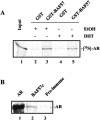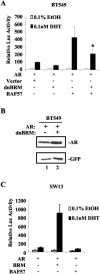BAF57 governs androgen receptor action and androgen-dependent proliferation through SWI/SNF
- PMID: 15743818
- PMCID: PMC1061596
- DOI: 10.1128/MCB.25.6.2200-2215.2005
BAF57 governs androgen receptor action and androgen-dependent proliferation through SWI/SNF
Abstract
Androgen receptor (AR) activity is required for prostate cancer development and progression. Thus, there is a major impetus to understand the regulation of AR action. We and others have previously shown that AR transactivation potential is dependent on the presence of an active SWI/SNF chromatin remodeling complex. However, the mechanisms underlying SWI/SNF regulation of the AR remained unsolved. We show here that the BAF57 subunit, an accessory component of the remodeling complex, is a critical regulator of AR function. We show that BAF57 is expressed in the luminal epithelia of the prostate and is required for AR-dependent transactivation in prostatic adenocarcinoma cells. Our data reveal that BAF57 can directly bind to the AR and is recruited to endogenous AR targets upon ligand activation. Loss of BAF57 or inhibition of BAF57 function severely compromised AR activity, as observed with both exogenous and endogenous AR targets. Rescue of BAF57 function restored AR activity, thus demonstrating a specific requirement of BAF57 for AR activity. This action of BAF57 proved to be dependent on SWI/SNF ATPase function. BAF57 has previously been implicated in nuclear receptor coactivator function, and we show that, although BAF57 facilitated coactivator activity, only a selected subset required BAF57 for coactivator function. Lastly, we demonstrate that both BAF57 and BRM are required for the proliferation of AR-dependent prostatic adenocarcinoma cells. In summary, these findings identify BAF57 as a critical modulator of the AR that is capable of altering AR activity, coactivator function, and AR-dependent proliferation.
Figures









Similar articles
-
Targeting the BAF57 SWI/SNF subunit in prostate cancer: a novel platform to control androgen receptor activity.Cancer Res. 2008 Jun 15;68(12):4551-8. doi: 10.1158/0008-5472.CAN-07-6392. Cancer Res. 2008. PMID: 18559499 Free PMC article.
-
Glioma tumor suppressor candidate region gene 1 (GLTSCR1) and its paralog GLTSCR1-like form SWI/SNF chromatin remodeling subcomplexes.J Biol Chem. 2018 Mar 16;293(11):3892-3903. doi: 10.1074/jbc.RA117.001065. Epub 2018 Jan 26. J Biol Chem. 2018. PMID: 29374058 Free PMC article.
-
Differential requirement of SWI/SNF for androgen receptor activity.J Biol Chem. 2003 Aug 15;278(33):30605-13. doi: 10.1074/jbc.M304582200. Epub 2003 May 29. J Biol Chem. 2003. PMID: 12775722
-
The SWI/SNF complex and cancer.Oncogene. 2009 Apr 9;28(14):1653-68. doi: 10.1038/onc.2009.4. Epub 2009 Feb 23. Oncogene. 2009. PMID: 19234488 Review.
-
The developmental and pathogenic roles of BAF57, a special subunit of the BAF chromatin-remodeling complex.FEBS Lett. 2016 Jun;590(11):1555-69. doi: 10.1002/1873-3468.12201. Epub 2016 May 20. FEBS Lett. 2016. PMID: 27149204 Review.
Cited by
-
HMGB1 in health and disease.Mol Aspects Med. 2014 Dec;40:1-116. doi: 10.1016/j.mam.2014.05.001. Epub 2014 Jul 8. Mol Aspects Med. 2014. PMID: 25010388 Free PMC article. Review.
-
Expression of BAF57 in ovarian cancer cells and drug sensitivity.Cancer Sci. 2015 Apr;106(4):359-66. doi: 10.1111/cas.12612. Epub 2015 Feb 25. Cancer Sci. 2015. PMID: 25611552 Free PMC article.
-
The BRG1 transcriptional coregulator.Nucl Recept Signal. 2008 Feb 1;6:e004. doi: 10.1621/nrs.06004. Nucl Recept Signal. 2008. PMID: 18301784 Free PMC article. Review.
-
Structural and functional analysis of domains of the progesterone receptor.Mol Cell Endocrinol. 2012 Jan 30;348(2):418-29. doi: 10.1016/j.mce.2011.07.017. Epub 2011 Jul 22. Mol Cell Endocrinol. 2012. PMID: 21803119 Free PMC article. Review.
-
Nuclear receptor coactivators: structural and functional biochemistry.Biochemistry. 2011 Jan 25;50(3):313-28. doi: 10.1021/bi101762x. Epub 2010 Dec 29. Biochemistry. 2011. PMID: 21141906 Free PMC article. Review.
References
-
- Balk, S. P. 2002. Androgen receptor as a target in androgen-independent prostate cancer. Urology 60:132-139. - PubMed
-
- Battaglioli, E., M. E. Andres, D. W. Rose, J. G. Chenoweth, M. G. Rosenfeld, M. E. Anderson, and G. Mandel. 2002. REST repression of neuronal genes requires components of the hSWI.SNF complex. J. Biol. Chem. 277:41038-41045. - PubMed
-
- Belandia, B., and M. G. Parker. 2003. Nuclear receptors: a rendezvous for chromatin remodeling factors. Cell 114:277-280. - PubMed
-
- Betz, B. L., M. W. Strobeck, D. N. Reisman, E. S. Knudsen, and B. E. Weissman. 2002. Re-expression of hSNF5/INI1/BAF47 in pediatric tumor cells leads to G1 arrest associated with induction of p16ink4a and activation of RB. Oncogene 21:5193-5203. - PubMed
Publication types
MeSH terms
Substances
Grants and funding
LinkOut - more resources
Full Text Sources
Medical
Research Materials
